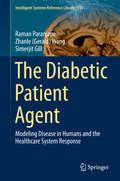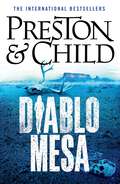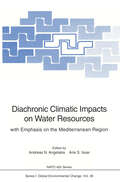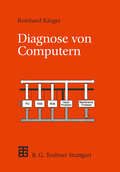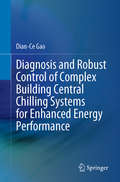- Table View
- List View
Dhaka Megacity: Geospatial Perspectives on Urbanisation, Environment and Health (Springer Geography)
by Ashraf Dewan Robert CornerThe book Dhaka Megacity: Geospatial Perspectives on Urbanisation, Environment and Health presents the use of geospatial techniques to address a number of environmental issues, including land use change, climatic variability, urban sprawl, population density modelling, flooding, environmental health, water quality, energy resources, urban growth modelling, infectious diseases and the quality of life. Although the work is focused on the Megacity of Dhaka in Bangladesh, the techniques and methods that are used to research these issues can be utilized in any other areas where rapid population growth coupled with unplanned urbanization is leading to environmental degradation. The book is useful for people working in the area of Geospatial Science, Urban Geography, Environmental Management and International Development. Since the chapters in the book cover a range of environmental issues, this book describes useful tools for assisting informed decision making, particularly in developing countries.
The Diabetic Patient Agent: Modeling Disease in Humans and the Healthcare System Response (Intelligent Systems Reference Library #133)
by Raman Paranjape Zhanle Gerald Wang Simerjit GillThis book provides a pioneering approach to modeling the human diabetic patient using a software agent. It is based on two MASc (Master of Applied Science) theses: one looking at the evolution of the patient agent in time, and another looking the interaction of the patient agent with the healthcare system. It shows that the software agent evolves in a manner analogous to the human patient and exhibits typical attributes of the illness such as reacting to food consumption, medications, and activity. This agent model can be used in a number of different ways, including as a prototype for a specific human patient with the purpose of helping to identify when that patient’s condition deviates from normal variations. The software agent can also be used to study the interaction between the human patient and the health care system. This book is of interest to anyone involved in the management of diabetic patients or in societal research into the management of diabetes. The diabetic patient agent was developed using the Ackerman model for diabetes, but this model can be easily adapted for any other model subject with the necessary physiological data to support that model.
Diablo Mesa (Nora Kelly)
by Douglas Preston Lincoln ChildFan favourites Nora Kelly and Corrie Swanson return in the new thriller from international bestsellers Preston & Child. Forced to leave her post at the Santa Fe Archaeological Institute, Nora Kelly is left without a job and without any prospects. So when billionaire Lucas Tappan invites her to lead his excavation of the infamous Roswell landing site, she has no choice but to make a decision that could destroy her reputation.Armed with a healthy dose of scepticism, Nora reluctantly agrees to visit. When the preliminary scans of the area reveal a suspected Native American burial site, Nora takes a closer look.But this is no indigenous burial site. It's a crime scene, and a recent one at that. Nora uncovers two dead bodies, one with a bullet hole in its skull, acid used to conceal the identities. Dead bodies mean this has become a case for the FBI, and Nora knows just the person to investigate – Special Agent Corrie Swanson.As Corrie and Nora dig deeper into the mystery, they will uncover more questions than answers. And the truth they seek will be even stranger than the conspiracy it hides behind...'Down-to-earth action tackles an otherworldly mystery in this devilishly plausible yarn' KIRKUS starred review
Diachronic Climatic Impacts on Water Resources: with Emphasis on the Mediterranean Region (Nato ASI Subseries I: #36)
by Andreas N. Angelakis and Arie S. IssarSince the beginning of man's existence on Earth, the adequacy of available water has been as important as any other factor for man's survival and prosperity. The volume comprises comprehensive reviews on: Paleoenvironments of arid land, climate-water-man interactions, water resources in the Minoan era, ancient Greek examples of avoiding water shortages, climatic changes in the eastern Mediterranean region since 5000 B.C., climatic evolution in ancient civilizations based on fossil studies, impact of climatic changes on groundwater and Mediterranean wetlands. The book is written for civil and agricultural engineers, hydrologists, geologists, environmental scientists and researchers. It is also useful as a reference to consulting engineers, agriculturists, environmentalists and students.
Diachronic Perspectives on Embodiment and Technology: Gestures and Artefacts (Philosophy of Engineering and Technology #46)
by Thiemo Breyer Alexander Matthias Gerner Niklas Grouls Johannes F. M. SchickThis book investigates the relationships between gestures and artefacts theoretically and historically, by analyzing different phenomena stemming from a variety of fields such as robotics, archaeology, gesture studies, anthropology, philosophy, and gestural practices like choreography, music performance, and composition. It underlines how embodiment and technology change the interplay between maker and artefact over time and appeals to students and researchers in these fields. Its goal is to enable the reader to understand that the recurring topics and questions as well as multi-level similarities are by no means accidental, but can best be understood if one pays attention to the intertwinements of materiality and cognition, praxis and techne.
Diagnosability, Security and Safety of Hybrid Dynamic and Cyber-Physical Systems
by Moamar Sayed-MouchawehCyber-physical systems (CPS) are characterized as a combination of physical (physical plant, process, network) and cyber (software, algorithm, computation) components whose operations are monitored, controlled, coordinated, and integrated by a computing and communicating core. The interaction between both physical and cyber components requires tools allowing analyzing and modeling both the discrete and continuous dynamics. Therefore, many CPS can be modeled as hybrid dynamic systems in order to take into account both discrete and continuous behaviors as well as the interactions between them. Guaranteeing the security and safety of CPS is a challenging task because of the inherent interconnected and heterogeneous combination of behaviors (cyber/physical, discrete/continuous) in these systems. This book presents recent and advanced approaches and tech-niques that address the complex problem of analyzing the diagnosability property of cyber physical systems and ensuring their security and safety against faults and attacks. The CPS are modeled as hybrid dynamic systems using different model-based and data-driven approaches in different application domains (electric transmission networks, wireless communication networks, intrusions in industrial control systems, intrusions in production systems, wind farms etc.). These approaches handle the problem of ensuring the security of CPS in presence of attacks and verifying their diagnosability in presence of different kinds of uncertainty (uncertainty related to the event occurrences, to their order of occurrence, to their value etc.).
Diagnose steuerungsexterner Fehler an Fertigungseinrichtungen (ISW Forschung und Praxis #48)
by J. SchwagerDiagnosesystem für steuerungsperiphere Fehler an Fertigungseinrichtungen (ISW Forschung und Praxis #65)
by Werner GrimmDiagnosing Hemp and Cannabis Crop Diseases
by Dr Shouhua WangHemp and cannabis, both belonging to Cannabis sativa, have emerged as some of the most valuable crops because of their multiple functionalities - industrial, medicinal, and recreational uses. Like all other crops, they are at risk of diseases and pests. In certain cases, an entire hemp field can fail due to unexpected disease. As a new and highly regulated crop, research on Cannabis crop diseases is scarce, and the science of plant diagnostics is not well covered in the literature. Taking hemp/cannabis as a model crop, the book illustrates how to diagnose a disease problem and how to manage it effectively. It presents real disease cases encountered during crop production, and explains methods of diagnosis, both in the field and in the lab, in order to find out the cause(s). The book provides: ·A field and laboratory guide to diagnosing hemp and cannabis diseases and pest problems ·Ready-to-adopt skills, methods and protocols in plant diagnosis, which can be applied to other crops ·Over 300 colour photographs accompanied by a wealth of disease information, including field observations, unique symptoms, microscopic details, and molecular data. This book is essential for anyone who is interested in learning about Cannabis crop diseases, for crops grown in the field, and in indoor production facilities.
Diagnosis: Interpreting the Shadows
by Pat Croskerry Karen Cosby Mark L. Graber Hardeep SinghDespite diagnosis being the key feature of a physician's clinical performance, this is the first book that deals specifically with the topic. In recent years, however, considerable interest has been shown in this area and significant developments have occurred in two main areas: a) an awareness and increasing understanding of the critical role of clinical decision making in the process of diagnosis, and of the multiple factors that impact it, and b) a similar appreciation of the role of the healthcare system in supporting clinicians in their efforts to make accurate diagnoses. Although medicine has seen major gains in knowledge and technology over the last few decades, there is a consensus that the diagnostic failure rate remains in the order of 10-15%. This book provides an overview of the major issues in this area, in particular focusing on where the diagnostic process fails, and where improvements might be made.
Diagnosis: Interpreting the Shadows
by Pat Croskerry Karen Cosby Mark L. Graber Hardeep SinghDespite diagnosis being the key feature of a physician's clinical performance, this is the first book that deals specifically with the topic. In recent years, however, considerable interest has been shown in this area and significant developments have occurred in two main areas: a) an awareness and increasing understanding of the critical role of clinical decision making in the process of diagnosis, and of the multiple factors that impact it, and b) a similar appreciation of the role of the healthcare system in supporting clinicians in their efforts to make accurate diagnoses. Although medicine has seen major gains in knowledge and technology over the last few decades, there is a consensus that the diagnostic failure rate remains in the order of 10-15%. This book provides an overview of the major issues in this area, in particular focusing on where the diagnostic process fails, and where improvements might be made.
Diagnosis and Control of Diseases of Fish and Shellfish
by Brian Austin Aweeda Newaj-FyzulThere has been a continual expansion in aquaculture, such that total production is fast approaching that of wild-caught fisheries. Yet the expansion is marred by continued problems of disease. New pathogens emerge, and others become associated with new conditions. Some of these pathogens become well established, and develop into major killers of aquatic species. Diagnosis and Control of Diseases of Fish and Shellfish focuses on the diagnosis and control of diseases of fish and shellfish, notably those affecting aquaculture. Divided into 12 chapters, the book discusses the range of bacterial, viral and parasitic pathogens, their trends, emerging problems, and the relative significance to aquaculture. Developments in diagnostics and disease management, including the widespread use of serological and molecular methods, are presented. Application/dose and mode of action of prebiotics, probiotics and medicinal plant products used to control disease are examined, as well as the management and hygiene precautions that can be taken to prevent/control the spread of disease. This book will be a valuable resource for researchers, students, diagnosticians, veterinarians, fish pathologists and microbiologists concerned with the management of diseases of fish and shellfish.
Diagnosis and Control of Diseases of Fish and Shellfish
by Brian Austin Aweeda Newaj-FyzulThere has been a continual expansion in aquaculture, such that total production is fast approaching that of wild-caught fisheries. Yet the expansion is marred by continued problems of disease. New pathogens emerge, and others become associated with new conditions. Some of these pathogens become well established, and develop into major killers of aquatic species. Diagnosis and Control of Diseases of Fish and Shellfish focuses on the diagnosis and control of diseases of fish and shellfish, notably those affecting aquaculture. Divided into 12 chapters, the book discusses the range of bacterial, viral and parasitic pathogens, their trends, emerging problems, and the relative significance to aquaculture. Developments in diagnostics and disease management, including the widespread use of serological and molecular methods, are presented. Application/dose and mode of action of prebiotics, probiotics and medicinal plant products used to control disease are examined, as well as the management and hygiene precautions that can be taken to prevent/control the spread of disease. This book will be a valuable resource for researchers, students, diagnosticians, veterinarians, fish pathologists and microbiologists concerned with the management of diseases of fish and shellfish.
Diagnosis and Fault-Tolerant Control
by Mogens Blanke Michel Kinnaert Jan Lunze Marcel StaroswieckiFault-tolerant control aims at a gradual shutdown response in automated systems when faults occur. It satisfies the industrial demand for enhanced availability and safety, in contrast to traditional reactions to faults, which bring about sudden shutdowns and loss of availability.The book presents effective model-based analysis and design methods for fault diagnosis and fault-tolerant control. Architectural and structural models are used to analyse the propagation of the fault through the process, to test the fault detectability and to find the redundancies in the process that can be used to ensure fault tolerance. It also introduces design methods suitable for diagnostic systems and fault-tolerant controllers for continuous processes that are described by analytical models of discrete-event systems represented by automata. The book is suitable for engineering students, engineers in industry and researchers who wish to get an overview of the variety of approaches to process diagnosis and fault-tolerant control.The authors have extensive teaching experience with graduate and PhD students, as well as with industrial experts. Parts of this book have been used in courses for this audience. The authors give a comprehensive introduction to the main ideas of diagnosis and fault-tolerant control and present some of their most recent research achievements obtained together with their research groups in a close cooperation with European research projects.The third edition resulted from a major re-structuring and re-writing of the former edition, which has been used for a decade by numerous research groups. New material includes distributed diagnosis of continuous and discrete-event systems, methods for reconfigurability analysis, and extensions of the structural methods towards fault-tolerant control. The bibliographical notes at the end of all chapters have been up-dated. The chapters end with exercises to be used in lectures.
Diagnosis and Fault-Tolerant Control
by Mogens Blanke Michel Kinnaert Jan Lunze Marcel StaroswieckiThis book presents model-based analysis and design methods for fault diagnosis and fault-tolerant control. Architectural and structural models are used to analyse the propagation of the fault through the process, test fault detectability and reveal redundancies that can be used to ensure fault tolerance. Case studies demonstrate the methods presented. The second edition includes new material on reconfigurable control, diagnosis of nonlinear systems, and remote diagnosis, plus new examples and updated bibliography.
Diagnosis and Fault-Tolerant Control
by Mogens Blanke Michel Kinnaert Jan Lunze Marcel StaroswieckiThis book presents model-based analysis and design methods for fault diagnosis and fault-tolerant control. Architectural and structural models are used to analyse the propagation of the fault through the process, test fault detectability and reveal redundancies that can be used to ensure fault tolerance. Case studies demonstrate the methods presented. The second edition includes new material on reconfigurable control, diagnosis of nonlinear systems, and remote diagnosis, plus new examples and updated bibliography.
Diagnosis and Fault-tolerant Control 1: Data-driven and Model-based Fault Diagnosis Techniques
by Vicenc Puig Silvio SimaniThis book presents recent advances in fault diagnosis strategies for complex dynamic systems. Its impetus derives from the need for an overview of the challenges of the fault diagnosis technique, especially for those demanding systems that require reliability, availability, maintainability and safety to ensure efficient operations. Moreover, the need for a high degree of tolerance with respect to possible faults represents a further key point, primarily for complex systems, as modeling and control are inherently challenging, and maintenance is both expensive and safety-critical.Diagnosis and Fault-tolerant Control 1 also presents and compares different diagnosis schemes using established case studies that are widely used in related literature. The main features of this book regard the analysis, design and implementation of proper solutions for the problems of fault diagnosis in safety critical systems. The design of the considered solutions involves robust data-driven, model-based approaches.
Diagnosis and Fault-tolerant Control 1: Data-driven and Model-based Fault Diagnosis Techniques
by Vicenç Puig Silvio SimaniThis book presents recent advances in fault diagnosis strategies for complex dynamic systems. Its impetus derives from the need for an overview of the challenges of the fault diagnosis technique, especially for those demanding systems that require reliability, availability, maintainability and safety to ensure efficient operations. Moreover, the need for a high degree of tolerance with respect to possible faults represents a further key point, primarily for complex systems, as modeling and control are inherently challenging, and maintenance is both expensive and safety-critical.Diagnosis and Fault-tolerant Control 1 also presents and compares different diagnosis schemes using established case studies that are widely used in related literature. The main features of this book regard the analysis, design and implementation of proper solutions for the problems of fault diagnosis in safety critical systems. The design of the considered solutions involves robust data-driven, model-based approaches.
Diagnosis and Fault-tolerant Control Volume 2: From Fault Diagnosis to Fault-tolerant Control
by Vicenç Puig Silvio SimaniThis book presents recent advances in fault diagnosis and fault-tolerant control of dynamic processes. Its impetus derives from the need for an overview of the challenges of the fault diagnosis technique and sustainable control, especially for those demanding systems that require reliability, availability, maintainability, and safety to ensure efficient operations. Moreover, the need for a high degree of tolerance with respect to possible faults represents a further key point, primarily for complex systems, as modeling and control are inherently challenging, and maintenance is both expensive and safety-critical.Diagnosis and Fault-tolerant Control 2 also presents and compares different fault diagnosis and fault-tolerant schemes, using well established, innovative strategies for modeling the behavior of the dynamic process under investigation. An updated treatise of diagnosis and fault-tolerant control is addressed with the use of essential and advanced methods including signal-based, model-based and data-driven techniques. Another key feature is the application of these methods for dealing with robustness and reliability.
Diagnosis and Fault-tolerant Control Volume 2: From Fault Diagnosis to Fault-tolerant Control
by Vicenc Puig Silvio SimaniThis book presents recent advances in fault diagnosis and fault-tolerant control of dynamic processes. Its impetus derives from the need for an overview of the challenges of the fault diagnosis technique and sustainable control, especially for those demanding systems that require reliability, availability, maintainability, and safety to ensure efficient operations. Moreover, the need for a high degree of tolerance with respect to possible faults represents a further key point, primarily for complex systems, as modeling and control are inherently challenging, and maintenance is both expensive and safety-critical.Diagnosis and Fault-tolerant Control 2 also presents and compares different fault diagnosis and fault-tolerant schemes, using well established, innovative strategies for modeling the behavior of the dynamic process under investigation. An updated treatise of diagnosis and fault-tolerant control is addressed with the use of essential and advanced methods including signal-based, model-based and data-driven techniques. Another key feature is the application of these methods for dealing with robustness and reliability.
Diagnosis and Prediction (The IMA Volumes in Mathematics and its Applications #114)
by Seymour GeisserA collection of refereed papers from a six-week workshop on statistics in the health sciences, that brought together theoretical and applied statisticians from universities, medical and public health schools, government and private research institutions, and pharmaceutical companies involved in prediction problems in the life and social sciences and in diagnostic and screening tests. A number of papers with applications were presented and particularly lively discussions ensued involving the critical issues and difficulties in using and interpreting diagnostic tests and implementing mass screening programs. The prediction or controlling future events, such as survival, comparative survival and survival post intervention for a disease or even for certain biological or natural events was also represented by participants who presented work that devised predictive methodology for a variety of problems mainly from a Bayesian perspective.
Diagnosis and Robust Control of Complex Building Central Chilling Systems for Enhanced Energy Performance
by Dian-Ce GaoThis book discusses enhancing the overall energy performance of building central air-conditioning systems through fault diagnosis and robust control strategies. Fault diagnosis strategies aim to determine the exact cause of problems and evaluate the energy impact on the system, while robust control strategies aim to manage chilled water systems to avoid the occurrence of low delta-T syndrome and deficit flow problems. Presenting the first academic study of the diagnostic method and control mechanism of “small temperature difference syndrome”, the book describes the highly robust and adaptive fault-tolerant control method developed to overcome the influences of external disturbance on the process control in practical applications. The diagnostic technology developed provides a predictive assessment of the energy dissipation effect of the fault. This book is a valuable reference resource for researchers and designers in the areas of building energy management and built environment control, as well as for senior undergraduate and graduate students.
Diagnosis and Treatment of Cancer using Thermal Therapies: Minimal and Non-invasive Techniques
by Citlalli J. Trujillo-Romero Dora-Luz FloresNew research is being conducted in the diagnosis and new treatments of cancer that has high efficacy and are minimally invasiveness. Artificial intelligence, bioimpedance, thermal images and nanomaterials have been used to provide early diagnosis. New treatments based on the generation of microwaves, radiofrequency, or ultrasound have been proposed in the last couple of decades. Although thermotherapies have been shown to be efficient, for them to be considered as a primary treatment, they must overcome some hurdles. One of the main challenges is to ensure applicators that point the electromagnetic or the mechanical waves at a tumor, don't affect the surrounding healthy tissues. In some cases, nanoparticles have also been designed to achieve better focus. The design of new applicators can be made by computational models based on methods such as the finite element. However, to efficiently predict the applicator’s performance, it is important that dielectric, thermal, and acoustic properties (tissue characterization) are included in the models. Not only healthy tissue, but also tumors must be characterized. Patient specific treatment planning, which consists of a 3D patient model based on medical images, can be developed to implement a safety treatment. Moreover, tissue properties as well as the applicator must be defined. Parameters such as temperature increase, and heat pattern must be evaluated to ensure patient safety and treatment success.
Diagnosis and Treatment of Cancer using Thermal Therapies: Minimal and Non-invasive Techniques
New research is being conducted in the diagnosis and new treatments of cancer that has high efficacy and are minimally invasiveness. Artificial intelligence, bioimpedance, thermal images and nanomaterials have been used to provide early diagnosis. New treatments based on the generation of microwaves, radiofrequency, or ultrasound have been proposed in the last couple of decades. Although thermotherapies have been shown to be efficient, for them to be considered as a primary treatment, they must overcome some hurdles. One of the main challenges is to ensure applicators that point the electromagnetic or the mechanical waves at a tumor, don't affect the surrounding healthy tissues. In some cases, nanoparticles have also been designed to achieve better focus. The design of new applicators can be made by computational models based on methods such as the finite element. However, to efficiently predict the applicator’s performance, it is important that dielectric, thermal, and acoustic properties (tissue characterization) are included in the models. Not only healthy tissue, but also tumors must be characterized. Patient specific treatment planning, which consists of a 3D patient model based on medical images, can be developed to implement a safety treatment. Moreover, tissue properties as well as the applicator must be defined. Parameters such as temperature increase, and heat pattern must be evaluated to ensure patient safety and treatment success.

